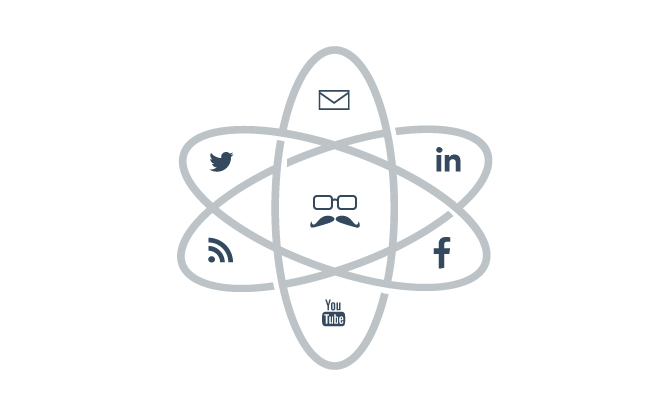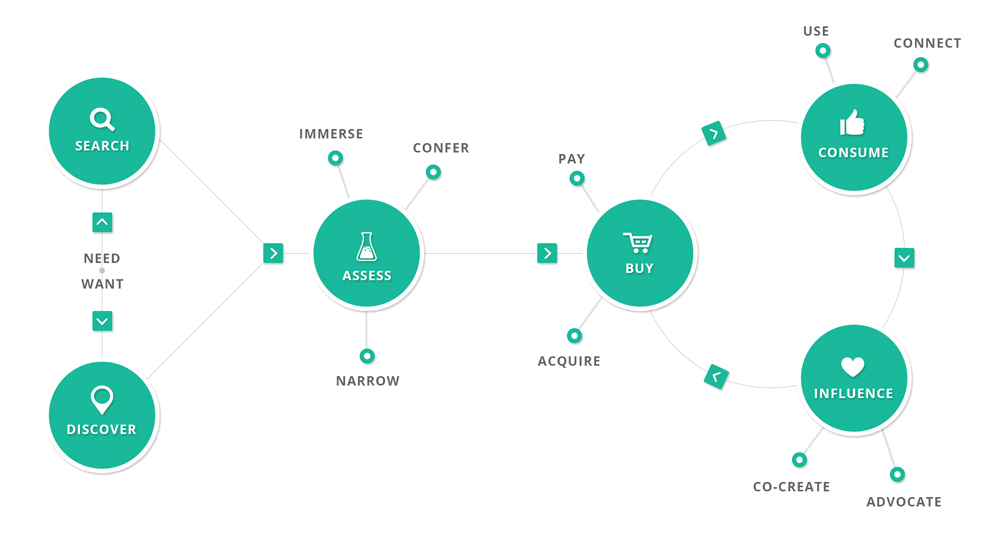
Several weeks ago, I was chatting with a business advisor and he began to talk about his client’s bad experience with social media and how he now thought it was an ineffective medium for a viable online marketing strategy.
I felt it necessary to note that social media’s role was being misunderstood and how it needed to be fully integrated with a solid online marketing strategy to be more effective.
The fact is that social media is essential for today's businesses. Though, to fully leverage this resource we must first understand its role and not fall for the preconception that it can stand alone in an online marketing strategy.
Understanding Social Media’s Role in the Consumer Journey
In order to comprehend the role social media plays in business, you must first understand the online consumer journey. The phenomenon refers to how users find you online and the decision making process which they go through in visiting your store, making a phone call, or purchasing your product/service online.

There are many available consumer journey outlines, but let's keep it simple and zoom in to 5 key steps every visitor typically goes through.
- Search/Discover
- Assess
- Buy
- Consume
- Influence
Let’s focus in on each of these steps and explain them a bit more thoroughly.
Search/Discover
Search/Discover refers to our Needs and Wants. Think back to the last time you needed to find the nearest doctor, how did you find this doctor? You guessed right; Google. You searched the search engines. Whether it be Google, Yahoo, or Bing, you found what you were looking for by clicking on the most convenient and relevant link.
It's not surprising, considering over 1 billion searches are being made on Google every month.
So to reiterate, Needs and Wants lead to the discovery of your business. Search and Discover is the first step of the consumer journey.
Assess
Once a visitor finds you online they’ll begin to assess whether your business was what they’re looking for. In this phase, you have to ensure you have the correct content strategy in place to market to your visitors effectively.
This is also associated with the Information Architecture and User Flow which means creating a site that is consumable and easy to navigate.
If it becomes too difficult for a visitor to find the information they need to make an informed decision whether they’re supposed to be on this site or not is what is going to make or break your business online. In a future article, I’ll discuss and detail what goes into Information Architecture, User Experience and User Flows.
Buy
Buying is pretty straight forward. If a visitor finds exactly what they are looking for and you’ve marketed to them effectively, they’ll buy, signup for your newsletter, make a call, etc. Which, in essence, is what we all want.
Consume
Once a user buys, they position themselves perfectly to engage with you. They initiate the process by consuming your product, using it and connecting with you through social media.
Influence
After a user experiences your product/service they’ll have the opportunity to become influencers, which is the best step of all, if the consumer loves your product. They’ll become brand advocate and co-creators of online content.
This is great because they become assets to your brand. They’ll tweet about you, post pictures, review, and share as much as of their experience as possible.
Where does Social Media lie within the Consumer Journey?
At Bridge, we believe social media holds its most value at the Search/Discover and the Influence phases. Social Media is perfect for engagement because of the 1 to 1 communication it creates with the end user and the brand. Which, in turn, allows businesses to be receptive to their consumers and speak to them directly.
What’s great is that users have the ability to co-create with you. Your client creates opportunities by allowing their network of acquaintances to view your site/product that is privy to your business. The Consume and Influence stages mainly speaks to your existing customers, but depending on the how you leverage this strategy and how large your audience is, we would consider this a viable option for acquiring new customers.
But if you’re a start-up, we recommend you take a different approach, which brings us to the initial Search/Discover stage. By using tools such as Twitter for Business and Facebook Advertising you will be able to increase the awareness and exposure of your business in hopes of acquiring new leads and clients.
How does it come together?
Let's use a real example to drive the idea home.
A college student (Amy) logins to her Facebook account and makes a post saying "having a bad tooth ache...anyone recommend any dentist in the valley?"
That post generates 4-6 comments with friends and families listing businesses but only 2 have a Facebook and only 1 has a website.
Amy is only interested in the two dentist with an online presence because in her mind, the mind of the consumer, if she can't connect with you easily, you don't exist to her.
She clicks on both dentist Facebooks. One is in McAllen where she lives and the other in Harlingen. McAllen Dentistry's Facebook page is boring and hasn't been updated for months, on top of that has outdated contact information. She searches for the company name on Google, but soon realizes McAllen Dentistry doesn't have a website. Without having sufficient information, Amy stops the search.
Harlingen's Dentistry's page is lively with updated posts, pictures and people commenting and rating. Amy then sees they have an article on tooth aches posted by the Harlingen Dentistry and clicks on it. It opens their website and directs them to a blog managed by the dentist themselves. The blog gives people advice on home remedies to manage too aches and when to see a dentist. Amy finds it helpful but still wants to see a dentist. That Facebook page, the website design, and blog post has gained her Trust.
She is 50% sure now they can help her but still need more convincing. At the bottom of the blog there's a call to action. It says if you're having a tooth ache schedule an appointment with us and use this promo cod for 15% off your visit. So she clicks on the link and it opens the HD's website where she is able to schedule herself.
While on the site she checks out the walk through off the office and sees how cool it is and feels this is "totally her". She relates. Then she reads reviews from patients and after reading a review about a tooth ache being fixed it has now pushed her 50% buying rate to 90%.
That last 10% is completed when she visits and experiences the brand herself.
Of course, this is only one path way and there are many others. But the idea is the same, people want to have easy access to your company and they will usually follow these steps to learn about a company before they decide to call, visit or purchase from them.
Conclusion
Our best advice is to use social media for what it was meant for; connecting with real people and engaging with them. It also gives you the opportunity to let them know about you and what you’re company is about. Establishing trust and credibility.
Looking back on the consumer journey, how are you using social media? Are you engaging with your existing customers or trying to acquire new ones?
The truth is; social media is only one piece of a larger puzzle. In our next article, we will look at how to create a holistic online marketing strategy that’ll get the results you are looking for.
